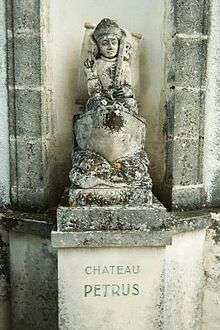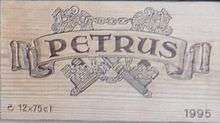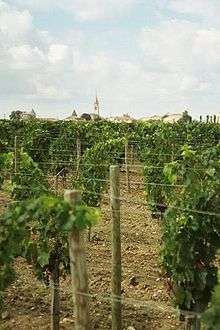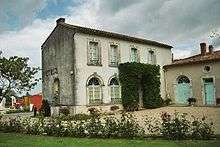Pétrus (wine)
Coordinates: 44°55′51″N 0°11′34″W / 44.93073°N 0.19285°W



Pétrus is a Bordeaux wine estate located in the Pomerol appellation near its eastern border to Saint-Émilion. A small estate of just 11.4 hectares (28 acres), it produces a red wine entirely from Merlot grapes since the end of 2010 and produces no second wine. The estate belongs to Jean-François Moueix and his children.
Although the wines of Pomerol have never been classified, Petrus is widely regarded as the outstanding wine of the appellation.[1][2][3][4][5][6][7][8] Petrus leads a duo of Pomerol estates in extreme prices, along with Le Pin, that rank consistently among the world's most expensive wines.[9][10] Indeed, a 750ml bottle of Petrus wine is priced at an average of $2,630.[11]
History
Originally a 7-hectare (17-acre) vineyard,[1] the estate was owned by the Arnaud family since the end of the 18th century,[7] and the name first appears in records from 1837.[5] In the 1868 edition of Cocks & Féret, under listing Crus bourgeois et 1ers artisans Château Petrus was ranked behind Vieux Château Certan and alongside Château Trotanoy.[4] Some vintages of this period were labelled Petrus-Arnaud.[9] At the Paris Exposition Universelle of 1878, Petrus won a gold medal,[3] at a time when such an event had very significant results, establishing a selling price at the level of a Médoc second growth,[4] the first wine of Pomerol to do so.[1]
In 1917, the Arnaud family had to sell and La Société Civile du Château Petrus, a share-holding company was set up. Around 1925, the owner of the Hôtel Loubat in Libourne, the widow Mme. Edmond Loubat, began to buy shares in the estate and continued the acquisition progressively until 1940, when she became the sole owner of the domaine.[7][12]
According to David Peppercorn, "the great age of Petrus" began with the end of World War II and the successful 1945 vintage.[1] Jean-Pierre Moueix of the Libourne négociant house Établissements Jean-Pierre Moueix acquired exclusive selling rights of Petrus in that year and the international reputation of Petrus began to grow.[12] Mme. Loubat, who also owned Château Latour à Pomerol, remained an active vigneronne throughout her life, known for her meticulous dedication to detail and quality, and strong determination that her wine deserved to be priced equal to the great crus.[1][2][7][8]
In the following years the efficient partnership with Moueix became prosperous.[8][9][10] Petrus became introduced to the United States,[5] [13] In 1947 Mme. Loubat presented two magnums of 1938 Petrus to the Lord Mayor of London, who had come to Pomerol for a visit, for the wedding of Princess Elizabeth.
After the 1956 winter frost that devastated the grapevines of the Bordeaux region and killed two-thirds of the Petrus vineyard,[6] Mme. Loubat decided not to replant but to coppice (cut back severely) the vines on surviving rootstocks; this process of recépage had been previously untried in the region;[6] her success ensured that the vines' average age remained high and established a tradition that has since been followed.[5][9]
Petrus' fame in the U.S. grew in the 1960s, with the promotion by Henri Soulé, owner of the restaurant Le Pavillon in New York. According to Alexis Lichine, "[Petrus] was served at Le Pavillon in the days when Onassis sat at a corner table. After that, Château Petrus became a status symbol, the sort of name dropped by people who wish to imply not only that they know wine but that they are in wine".[14]
On the death of Mme. Loubat in 1961, the estate was divided between a niece and nephew, Mme. Lily Lacoste-Loubat and M. Lignac, and a share was left to JP Moueix to allow for equality between the two heirs, thought to be in conflict, and to ensure Moueix' continued influence.[6] For a period the estate was represented by the niece,[1][5] but in 1964, JP Moueix bought the Lignac shares,[12] and the oenologist Jean-Claude Berrouet became permanently attached to Petrus.[9][15] Prior to this, Émile Peynaud had been employed as a part-time consultant.[16] In 1969, 5 hectares (12 acres) of vineyard were added to the estate, purchased from neighbouring Château Gazin.[1][9][12]
Following the death of Jean-Pierre Moueix in 2003, his son Jean-François Moueix, head of Groupe Duclot, is the owner of Petrus together; he and his children have controlled distribution worldwide via Clés Distribution since 2014. When Jean-Claude Berrouet retired as technical director after 45 vintages in 2008 he was replaced by his son Olivier Berrouet, who now manages the vineyard and the wine making.
Production
The vineyard of Petrus extends 11.4 hectares (28 acres) and is located on a plateau in the eastern portion of Pomerol. The grape variety distribution is 100% Merlot since the end of 2010.[9]
Located on top of a 20-hectare (49-acre) island mound, the Petrus boutonnière or buttonhole, Petrus' original vineyard possesses topsoil and subsoil high in iron-rich clay that differs from neighbouring vineyards, where the soil is a mixture of gravel-sand or clay-sand.
The average age of the vines exceed 45 years.[5][9] The estate was among the first in Bordeaux to implement green-harvesting or éclaircissage as a way to lower crop yields and raise the quality of the remaining grapes. Grapes are hand harvested over two to three days,[9] although the vineyard's small size permits harvesting to be completed in one day if necessary.[12]
A severe pre-assemblage vat selection is carried out and certain parcels are rejected from the Grand Vin. The young wine is aged in 50% new French oak barrels for 12 to 16 months.[9][12] An average year might yield at most 30,000 bottles.
 Petrus vineyards.
Petrus vineyards. The Petrus country house.
The Petrus country house.
References
- 1 2 3 4 5 6 7 Peppercorn, David (2003). Bordeaux. London: Mitchell Beazley. pp. 519–523. ISBN 1-84000-927-6.
- 1 2 Lichine, Alexis (1967). Alexis Lichine's Encyclopedia of Wines and Spirits (1st ed.). London: Cassell & Company Ltd. p. 400.
- 1 2 Shand, P. Morton (1964). Ray, Cyril, ed. A Book of French Wines (3rd ed.). Bristol: Penguin Books. p. 139.
- 1 2 3 Penning-Rowsell, Edmund (1969). The Wines of Bordeaux. London: The International Wine and Food Publishing Company. pp. 361–369. ISBN 0-14-046866-8.
- 1 2 3 4 5 6 Sutcliffe, Serena, (November 2, 2004). "Behind the Legend". Decanter.com.
- 1 2 3 4 Coates, Clive (1995). Grands Vins. University of California Press. pp. 448-453. ISBN 0-520-20220-1
- 1 2 3 4 Prial, Frank J. (September 26, 1990). "Wine Talk". The New York Times.
- 1 2 3 Faith, Nicholas (April 16, 2003). "Jean-Pierre Moueix". The Independent.
- 1 2 3 4 5 6 7 8 9 10 Kissack, Chris. "Petrus". thewinedoctor.com.
- 1 2 Lyons, William (April 29, 2003). "Obituary: Jean-Pierre Moueix". The Scotsman.
- ↑ "Petrus, Pomerol, France: prices | wine-searcher". Wine Searcher. Retrieved 2016-11-23.
- 1 2 3 4 5 6 Pitcher, Steve (April/May 1998). "Château Petrus-A Legendary Vertical Tasting". The Wine News.
- ↑ "Corking Petrus prices set to soar as experts announce it is the 'best vintage for 100 years'". Daily Mail.
- ↑ Henry, Gordon M.; Sachs, Andrea; Zagorin, Adam (March 10, 1986). "Divine Wine". TIME.
- ↑ Styles, Oliver (February 4, 2008). "Bordeaux en primeur is 'madness': Petrus winemaker". Decanter.com.
- ↑ Anson, Jane. "Jean Claude Berrouet". newbordeaux.com.
External links
-
 Media related to Château Petrus at Wikimedia Commons
Media related to Château Petrus at Wikimedia Commons